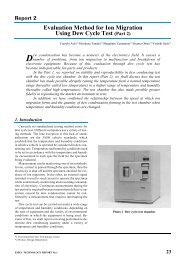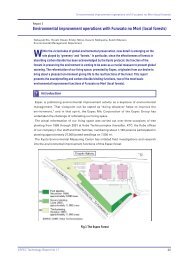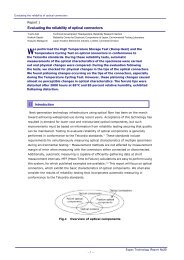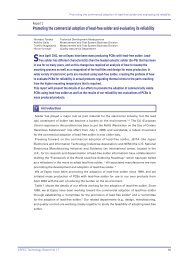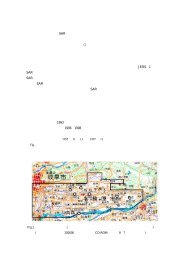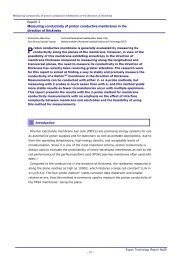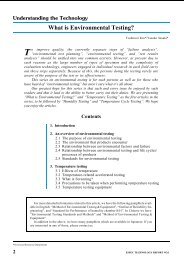download
download
download
Create successful ePaper yourself
Turn your PDF publications into a flip-book with our unique Google optimized e-Paper software.
Evaluating the reliability of optical connectors<br />
7<br />
The optical characteristics of the optical connectors reviewed for this study were<br />
automatically measured during the High Temperature Storage Test (Damp Heat) (at<br />
85°C and 85 percent relative humidity for 1000 hours) and the Temperature Cycling Test<br />
(at 85°C / -40°C for 500 cycles of one hour each). We obtained the following results.<br />
(1)No changes occurred in optical characteristics, but pistoning increased in the<br />
connectors.<br />
(2)Increased pistoning of the ferrule tips was observed in both the Temperature Cycling<br />
Test and the High Temperature Storage Test (Damp Heat), but the major changes<br />
occurred in the Temperature Cycling Test.<br />
(3)The post-test condition of the ferrule tips after testing at 85°C and 85 percent relative<br />
humidity for 2000 hours exhibited flattening distortion. This result could indicate that<br />
the actual pistoning was greater than the calculated amount.<br />
8<br />
Conclusion<br />
Topics for future discussion<br />
Many aspects of the relationship between pistoning and optical characteristics have yet<br />
to be confirmed, and topics such as manufacturing conditions also require research.<br />
[Terminology]<br />
*1.Telcordia<br />
The breakup of the American communications giant AT&T (Bell Telephone) created<br />
seven regional telephone providers (the so-called "Baby Bells") and established a<br />
research and development company initially called Bellcore. Later, when this<br />
subsidiary was sold to a company unrelated to the original Bell, the company became<br />
known as Telcordia Technologies. In the field of communications in the U.S., the<br />
Telcordia standards are widely referenced as the baseline standards for this field.<br />
*2.SC connectors, and *3. FC connectors<br />
Both of these optical connectors are zirconia ferrule (refer to Fig.2 above) connectors<br />
developed in Japan that are widely used throughout the world. The stationary part of<br />
the SC connector is made of plastic, and can be connected by merely being pressed<br />
on. The stationary part of the FC connector, though, is made of metal and must be<br />
attached with screws.<br />
*4.Insertion loss<br />
The transmission loss occurring when light passes through the part. This value<br />
compares the insertion light with the outgoing light, and is expressed in decibels.<br />
*5.Return loss<br />
This value compares the insertion light power and the reflected light power of the<br />
reflected light returning inside the part. This value is expressed in decibels.<br />
- 10 -<br />
Espec Technology Report No20



